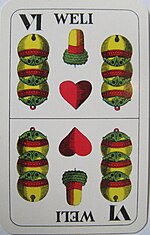Weli


TheWeli,formerlyWelli,is aplaying cardused in the Salzburg andWilliam Tell card decks,which areAustrianregional patterns of theGerman-suited playing cards.It has the value of 6 of Bells and, in theSouth Tyrolvariant of the card game,Watten,it is the only 6 used and can, in addition to its own suit of Bells, join the trump suits of Acorns, Hearts and Leaves. In all other variants of Watten, the 7 of Bells is theWeli.
History
[edit]TheWeliis also often called theWelliorBelliand, dialectically, theWöli,Wöüli,BölleorBelle.The nameWeliprobably comes from the Italian wordbelli,which means "bells".
Historically theWeliis first recorded in the early 1850s, when aBozencard manufacturer inscribedWELLIonto the six of bells. As early as 1855, theWeliwas integrated in the Salzburg pattern as the 6 of Bells.[1]The gravestone appearing in many depictions is probably the grave of theApostle Paul.
In the game ofJaggln,the Six of Bells is usually called theBuggl(Austrian dialect forBuckel,a hump or rounded object, perhaps referring to the shape of the bells).[2]
As a high trump
[edit]Games in which the Weli has the role of amatadori.e. high trump include:
- Préférence– in a variant played in western Austria the Weli is the 2nd highest trump.
- Watten– in the Austrian variant of Critical Watten, the Weli is sometimes the 2nd highest trump.
- Perlaggen– the Weli is the 2nd highest permanent 'Perlagg' which may then be used as a wild card (see below).
As a wild card
[edit]In the Austrian games ofBieten,andPerlaggen,theWeliacts as awild card,something which is illustrated by the depiction of two other suits (Acorns and Hearts) on the card and by its special design (it is the only playing card with a printed name).[3][4][5]In other games, it is simply the six of bells.
References
[edit]- ^Later Tyrol patternat theInternational Playing-Card Society
- ^Schipflinger, Anton (1927). "Das Jaggln" inTiroler Heimatblätter,Issue 7/8, pp. 230/231.
- ^McLeod, John.Wattenatpagat.com.Retrieved 1 June 2018.
- ^McLeod, John.Bietenlatpagat.com.Retrieved 1 June 2018.
- ^McLeod, John.Perlaggenatpagat.com.Retrieved 1 June 2018.
